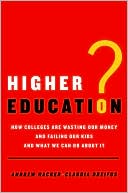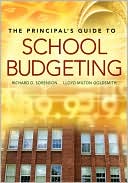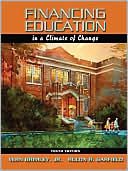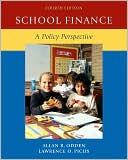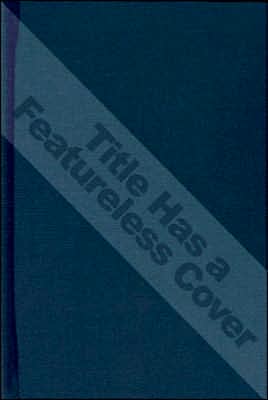Schoolhouses, Courthouses, and Statehouses: Solving the Funding-Achievement Puzzle in America's Public Schools
Spurred by court rulings requiring states to increase public-school funding, the United States now spends more per student on K-12 education than almost any other country. Yet American students still achieve less than their foreign counterparts, their performance has been flat for decades, millions of them are failing, and poor and minority students remain far behind their more advantaged peers. In this book, Eric Hanushek and Alfred Lindseth trace the history of reform efforts and conclude...
Search in google:
"Massive 'reforms' have poured billions of dollars into our schools, but we have yet to see results in terms of student achievement. It is time that we step back from the current bureaucratic policies that emphasize central control and regulation. We need to reward success not failure. This is exactly the message of this thoughtful book by Hanushek and Lindseth. It is a message that should be shouted from the rooftops of Washington and every state capital."--William J. Bennett, Claremont Institute, former U.S. Secretary of Education"Eric Hanushek and Alfred Lindseth do a remarkable job of shedding light on how we fund the education of America's children. In many cases, they find that, despite a tremendous increase in our financial investment in public schools during the last several decades, our students are falling farther behind their peers across the globe. We cannot continue to rely on arguments defending the status quo. School funding and education policy should empower leaders to advance innovative reform and ensure direct accountability for student achievement."--Jeb Bush, former governor of FloridaHanushek and Lindseth have penned a clear, empirically impressive, and insightful critique of court-driven efforts to improve public schools. This is a book destined to reshape debates about the role judges can and should play in twenty-first-century school reform."--Frederick Hess, author of Common Sense School Reform"This is a must-read for policymakers, parents, and the public. Too many people fail to understand the seriousness of the educational crises we face. Too many think that tinkering with the current system will be enough. This book not only sets out the dimensions of the problem clearly and forcefully but also provides a path for improvement."--Roy Romer, chairman of Strong Schools America, former Los Angeles school superintendent, and former Colorado governor"The way we fund schooling in America defies both common sense and fundamental decency. However, as Schoolhouses, Courthouses, and Statehouses shows, most recent efforts to reform school finance haven't made nearly the difference their proponents promised. For those interested in improving results in public schools, this is a must read. Everyone--including me--will find something to disagree with. But the book is thoughtful, provocative, and helpful in framing the core elements of a more promising approach."--Kati Haycock, president of the Education Trust"This book makes an important contribution to the subjects of school finance and school reform and the litigation surrounding them. The authors, a widely cited academic economist and an experienced lawyer who have both been involved in this litigation in many states, make a good team."--Michael Podgursky, author of Teacher Pay and Teacher Quality Chester Finn, Jr. - Education Gadfly This important new book by economist Eric Hanushek and attorney Alfred Lindseth is the most cogent and comprehensive analysis of America's school-finance challenges that I have ever seen.
List of Illustrations ix List of Tables xiii Preface xv Introduction 1Chapter 1: Just How Important Is Education? 10 Education and Financial Achievement 11 Education and Poverty 15 Education and the Nation's Economic Well-Being 16 Testing Student Skills 20 Quality of U.S. Colleges 21Chapter 2: U.S. Education at a Crossroads 23 Years of School Completed 23 Achievement Levels (or the Mastery of Cognitive Skills) 29 International Comparisons 36 Achievement Gaps 38Chapter 3: The Political Responses 44 Increased Spending and Resources for K-12 Education 45 Increased Equity in Funding for K-12 Education 57 The Standards and Accountability Movement 71 Increased School Choice Options 76 Teacher Certification 80 Conclusions 82Chapter 4: Court Interventions in School Finance 83 Federal Desegregation Litigation and Milliken II Remedies 84 "Equity" Cases 88 "Adequacy" Cases 95 Chapter 5: Practical Issues with Educational Adequacy 118 Defining an "Adequate" Education 118 The Element of Causation 129 Problems Relating to Remedy 136 Problems Inherent in the Makeup and Processes of the Courts 139Chapter 6: The Effectiveness of Judicial Remedies 145 Kentucky 147 Wyoming 151 New Jersey 157 Massachusetts 166Chapter 7: Science and School Finance Decision Making 171 A Simple Decision Model 172 How Much Is Enough? 173 How Should the Money Be Spent? 200 Using Science More Effectively 211Chapter 8: A Performance-Based Funding System 217 Guiding Principles: Back to Basics 218 A Performance-Based Funding System 219 Big City Schools 258 Conclusions 260Chapter 9: Making Performance-Based Funding a Reality 263 The Persistence of Illusory Spending Solutions 263 Support for the Status Quo and Resistance to Change 268 Some Current Countervailing Forces 275 Encouraging True Reform: Mutually Agreed Bargains 279 Changing the Focus of the Courts 281 Mobilizing for the Future 287Notes 291 Legal Citations 353 Federal Court Cases (arranged in alphabetical order) 353 State Court Cases (arranged by state and, within states, chronologically) 354 Sources for Figures and Tables 361 References 363 Index 395
\ Washington Post - Jay Mathews\ It is enlightening, maddening, hopeful, frustrating and amazingly informative. . . . The book provides a terrific summary of how the U.S. education system has changed since World War II. It makes a telling argument about how much our well-being depends on our schools. It eviscerates the policymaking that has ruled public education for the last half century. And it buries for all time the notion that getting the courts to fix our schools has any chance of success.\ \ \ \ \ Education Gadfly - Chester Finn\ This important new book by economist Eric Hanushek and attorney Alfred Lindseth is the most cogent and comprehensive analysis of America's school-finance challenges that I have ever seen.\ \ \ Washington PostIt is enlightening, maddening, hopeful, frustrating and amazingly informative. . . . The book provides a terrific summary of how the U.S. education system has changed since World War II. It makes a telling argument about how much our well-being depends on our schools. It eviscerates the policymaking that has ruled public education for the last half century. And it buries for all time the notion that getting the courts to fix our schools has any chance of success.\ — Jay Mathews\ \ \ \ \ ChoiceHanushek and Lindseth conclusively enlighten policy makers, professors, school administrators, legal and educational researchers, and undergraduate and graduate students of school administration by providing an exhaustive discussion of decades of school funding and the results for student achievement. . . . The authors' experience and expertise in school funding, research, and data analysis and their ideas for the future of funding and accountability make this an absolute must read.\ \ \ \ \ Education GadflyThis important new book by economist Eric Hanushek and attorney Alfred Lindseth is the most cogent and comprehensive analysis of America's school-finance challenges that I have ever seen.\ — Chester Finn, Jr.\ \

